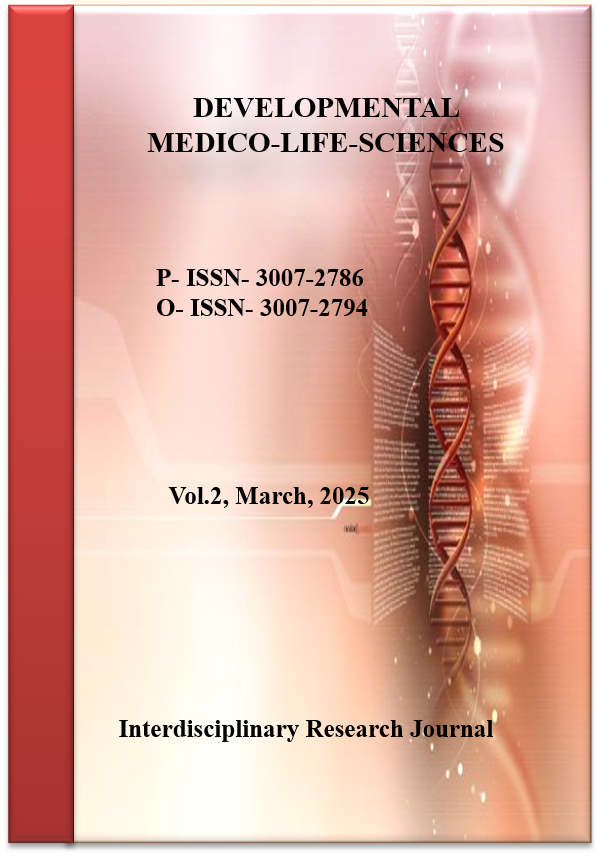Diagnostic Accuracy of Axillary Ultrasonography for Differentiating Benign and Malignant Lymph Nodes in Breast Cancer Patients
Axillary Ultrasound Accuracy
DOI:
https://doi.org/10.69750/dmls.02.03.099Keywords:
Ultrasound, Axillary lymph nodes, Diagnostic accuracy, Histopathology, Preoperative stagingAbstract
Background: Reliable evaluation of axillary lymph nodes before surgery is essential for determining prognosis and tailoring treatment in breast cancer care. Although surgical techniques such as sentinel-node biopsy remain the definitive standard, they are invasive and can cause considerable morbidity. High-resolution ultrasonography provides a non-invasive alternative.
Objectives: This study aimed to measure how accurately ultrasound distinguishes malignant from benign axillary nodes, using histopathology as the reference method.
Methods: We carried out a prospective observational study in a tertiary oncology hospital from January 2022 through December 2023. Eighty adults with biopsy-confirmed breast carcinoma underwent preoperative axillary ultrasound performed by senior breast radiologists with 7–15 MHz linear transducers. Each lymph node was assessed for size, shape, cortical thickness, integrity of the fatty hilum, and Doppler vascular pattern. Tissue obtained by surgical excision or image-guided core biopsy supplied the histological verdict. Sensitivity, specificity, positive predictive value (PPV), negative predictive value (NPV), and overall accuracy were calculated, and agreement with histology was expressed using Cohen’s κ statistic.
Results: Histological analysis identified metastasis in 42 patients (52.5 %) and benign pathology in 38 (47.5 %). Ultrasound achieved an overall accuracy of 86.3 %, with sensitivity 85.7 %, specificity 86.8 %, PPV 87.8 %, and NPV 84.6 %. Concordance between sonography and histopathology was substantial (κ = 0.72; p < 0.001).
Conclusion: When conducted under standardized conditions, axillary ultrasound reliably differentiates malignant from benign lymph nodes in breast-cancer patients. Incorporating this modality into routine preoperative work-ups could decrease reliance on invasive staging procedures and their attendant complications. Larger multicentre studies are warranted to confirm these findings and refine sonographic criteria further.
Downloads
References
Samiei S, van Nijnatten TJA, van Beek HC, Polak MPJ, Maaskant-Braat AJG, Heuts EM, et al. Diagnostic performance of axillary ultrasound and standard breast MRI for differentiation between limited and advanced axillary nodal disease in clinically node-positive breast cancer patients. Scientific Reports. 2019;9(1):17476.doi: 10.1038/s41598-019-54017-0
Agrawal S, Goel AD, Gupta N, Lohiya A, Gonuguntla HK. Diagnostic utility of endobronchial ultrasound (EBUS) features in differentiating malignant and benign lymph nodes - A systematic review and meta-analysis. Respiratory Medicine. 2020;171:106097.doi: https://doi.org/10.1016/j.rmed.2020.106097
Joshi P, Singh N, Raj G, Singh R, Malhotra KP, Awasthi NP. Performance evaluation of digital mammography, digital breast tomosynthesis and ultrasound in the detection of breast cancer using pathology as gold standard: an institutional experience. Egyptian Journal of Radiology and Nuclear Medicine. 2022;53(1):1.doi: 10.1186/s43055-021-00675-y
Assing MA, Patel BK, Karamsadkar N, Weinfurtner J, Usmani O, Kiluk JV, et al. A comparison of the diagnostic accuracy of magnetic resonance imaging to axillary ultrasound in the detection of axillary nodal metastases in newly diagnosed breast cancer. The Breast Journal. 2017;23(6):647-55.doi: https://doi.org/10.1111/tbj.12812
Di Paola V, Mazzotta G, Pignatelli V, Bufi E, D’Angelo A, Conti M, et al. Beyond N Staging in Breast Cancer: Importance of MRI and Ultrasound-based Imaging. Cancers [Internet]. 2022; 14(17).doi: 10.3390/cancers14174270
Elkharbotly A, Farouk HM. Ultrasound elastography improves differentiation between benign and malignant breast lumps using B-mode ultrasound and color Doppler. The Egyptian Journal of Radiology and Nuclear Medicine. 2015;46(4):1231-9.doi: https://doi.org/10.1016/j.ejrnm.2015.06.005
Zhang Q, Agyekum EA, Zhu L, Yan L, Zhang L, Wang X, et al. Clinical Value of Three Combined Ultrasonography Modalities in Predicting the Risk of Metastasis to Axillary Lymph Nodes in Breast Invasive Ductal Carcinoma. Frontiers in Oncology. 2021;11.doi: 10.3389/fonc.2021.715097
Huang H, Huang Z, Wang Q, Wang X, Dong Y, Zhang W, et al. Effectiveness of the Benign and Malignant Diagnosis of Mediastinal and Hilar Lymph Nodes by Endobronchial Ultrasound Elastography. J Cancer. 2017;8(10):1843-8.doi: 10.7150/jca.19819
Haghighi F, Naseh G, Mohammadifard M, Abdollahi N. Comparison of mammography and ultrasonography findings with pathology results in patients with breast cancer in Birjand, Iran. Electron Physician. 2017;9(10):5494-8.doi: 10.19082/5494
van Nijnatten TJA, Ploumen EH, Schipper RJ, Goorts B, Andriessen EH, Vanwetswinkel S, et al. Routine use of standard breast MRI compared to axillary ultrasound for differentiating between no, limited and advanced axillary nodal disease in newly diagnosed breast cancer patients. European Journal of Radiology. 2016;85(12):2288-94.doi: https://doi.org/10.1016/j.ejrad.2016.10.030
Schmachtenberg C, Fischer T, Hamm B, Bick U. Diagnostic Performance of Automated Breast Volume Scanning (ABVS) Compared to Handheld Ultrasonography With Breast MRI as the Gold Standard. Academic Radiology. 2017;24(8):954-61.doi: https://doi.org/10.1016/j.acra.2017.01.021
Rezkallah EMN, Elsaify A, Tin SMM, Elsaify W. Diagnostic Accuracy of Ultrasonography in Axillary Staging in Breast Cancer Patients. Journal of Medical Ultrasound. 2023;31(4).doi, https://journals.lww.com/jmut/fulltext/2023/31040/diagnostic_accuracy_of_ultrasonography_in_axillary.6.aspx
Okasha H, Elkholy S, Sayed M, El-Sherbiny M, El-Hussieny R, El-Gemeie E, et al. Ultrasound, endoscopic ultrasound elastography, and the strain ratio in differentiating benign from malignant lymph nodes. Arab Journal of Gastroenterology. 2018;19(1):7-15.doi: https://doi.org/10.1016/j.ajg.2018.01.001
Madan K, Madan M, Iyer H, Mittal S, Madan NK, Rathi V, et al. Utility of Elastography for Differentiating Malignant and Benign Lymph Nodes During EBUS-TBNA: A Systematic Review and Meta-analysis. Journal of Bronchology & Interventional Pulmonology. 2022;29(1).doi, https://journals.lww.com/bronchology/fulltext/2022/01000/utility_of_elastography_for_differentiating.5.aspx
Ibraheem SA, Mahmud R, Mohamad Saini S, Abu Hassan H, Keiteb AS, Dirie AM. Evaluation of Diagnostic Performance of Automatic Breast Volume Scanner Compared to Handheld Ultrasound on Different Breast Lesions: A Systematic Review. Diagnostics [Internet]. 2022; 12(2).doi: 10.3390/diagnostics12020541
Ji X, Li D, Gao D, Lv X, Feng Y, Zhang D, et al. Value of Ultrasound-Guided Biopsy in Evaluating Internal Mammary Lymph Node Metastases in Breast Cancer. Clinical Breast Cancer. 2021;21(6):532-8.doi: https://doi.org/10.1016/j.clbc.2021.04.016
Liu X, Wang M, Wang Q, Zhang H. Diagnostic value of contrast-enhanced ultrasound for sentinel lymph node metastasis in breast cancer: an updated meta-analysis. Breast Cancer Research and Treatment. 2023;202(2):221-31.doi: 10.1007/s10549-023-07063-2
Aktaş A, Gürleyik MG, Aydın Aksu S, Aker F, Güngör S. Diagnostic Value of Axillary Ultrasound, MRI, and (18)F-FDG-PET/ CT in Determining Axillary Lymph Node Status in Breast Cancer Patients. Eur J Breast Health. 2022;18(1):37-47.doi: 10.4274/ejbh.galenos.2021.2021-3-10






















